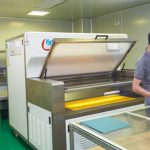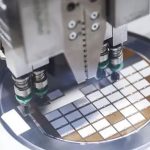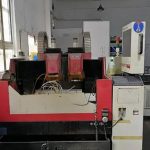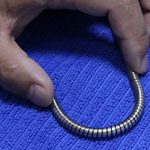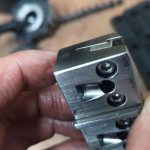Deprecated: get_settings is deprecated since version 2.1.0! Use get_option() instead. in /www/sites/alloy.wiki/index/wp-includes/functions.php on line 4862
1. The principle and characteristics of investment casting
Investment casting is also called precision casting or lost wax casting. It uses fusible materials (wax and plastics, etc.) to make precise fusible models. The models are coated with several layers of refractory coatings, which are dried and hardened into a whole The shell is then heated to melt the mold, and then fired at a high temperature to become a refractory shell. The liquid metal is poured into the shell, and the casting is formed after cooling.
Mold material-wax mold-group mold-mold repair-coating-sanding-demoulding-roasting-pouring-cooling-falling sand-cleaning.
Compared with other casting methods, the main advantages of investment casting are as follows:
- 1) Castings have high dimensional accuracy and low surface roughness, which can cast complex-shaped castings. The general accuracy can reach 5~7, and the roughness can reach two Ra25-6.3μm;
- 2) Thin-walled castings and low-weight castings can be cast. The minimum wall thickness of investment castings can reach 0.5mm, and the weight can be as small as a few grams;
- can cast fine patterns, characters, castings with fine grooves and curved pores;
- 3) The shape and cavity shape of investment castings are almost unlimited, and parts with complex shapes that are difficult to manufacture by sand casting, forging, cutting and other methods can be manufactured, and some assemblies and welded parts can be slightly structured. After the improvement, it is directly cast into integral parts, thereby reducing the weight of the parts and reducing the production cost;
- 4) There are almost no restrictions on the types of casting alloys. They are commonly used for casting alloy steel, carbon steel and heat-resistant alloy castings;
- 5) There is no limit to the production batch, which can be mass produced from single to batch.
The disadvantage of this casting method is that the process is complicated, the production cycle is long, and it is not suitable for the production of castings with large outline dimensions.
- Example 1: The Zun plate unearthed with the chime in 2400-unparalleled in the world, exquisite
- Example 2: Yunnan wax removal method and aviation blade casting technology
2. Types of mold materials and performance requirements
(1) Classification of mold materials
With the development of china investment casting technology, there are more and more types of mold materials with different compositions. Mold materials are usually divided into high temperature, medium temperature and low temperature mold materials according to their melting point.
The melting point of the low-temperature molding compound is lower than 60°C, and 50% of the paraffin-stearic acid molding compound currently widely used in my country belongs to this category;
The melting point of the high-temperature molding compound is higher than 120°C, and the molding compound composed of 50% rosin, 20% ozokerite, and 30% polystyrene is a typical high-temperature molding compound.
The melting point of the medium temperature mold material is between the above two types of mold materials. The currently used medium temperature mold materials can be basically divided into two types: rosin-based and wax-based mold materials.
(2) Basic requirements for mold material performance
Thermophysical properties: suitable melting temperature and solidification interval, small thermal expansion and contraction, high heat resistance (softening point), and the mold material should have no precipitates in the liquid state, and no phase change in the solid state;
Mechanical properties: mainly strength, hardness, plasticity, flexibility, etc.;
Process performance: Mainly include viscosity (or fluidity), ash content, coatability, etc.
3.Molding Process
According to the specified composition and proportion of the mold material, melt the various raw materials into a liquid state, mix and stir uniformly, filter out impurities and pour into a paste mold material, that is, the investment mold can be pressed. Press molding methods are commonly used to suppress investment molds. This method allows the use of liquid, semi-liquid, and solid and semi-solid mold materials. Liquid and semi-liquid mold materials are pressed and formed under low pressure, which is called injection molding; semi-solid or solid mold materials are pressed and formed under high pressure, which is called extrusion molding. Whether it is injection molding or extrusion molding, the advantages and disadvantages of filling and solidification must be considered.
(1) Injection molding
The wax injection temperature of pressure injection molding is mostly below the melting point. At this time, the mold material is a slurry or paste in which liquid and solid two phases coexist. In the slurry-like mold material, the amount of liquid phase significantly exceeds the amount of solid phase, so the fluidity of the liquid is still retained. Under pressure injection in this state, the surface of the investment mold has low roughness, and surface defects caused by turbulence and splashing are not easy to appear. The temperature of the paste mold material is lower than that of the paste mold material, and it has lost fluidity. Although there are few surface defects, it has a higher surface roughness.
When the mold material is injection molded, the lowest mold material temperature and pressing working temperature should be used as far as possible under the condition of ensuring good filling. The choice of pressure is not the greater the better. Although the pressure is high, the shrinkage rate of the investment is small, but the pressure and injection speed are too large, which will make the surface of the investment not smooth and produce “bubbles” (bubble expansion under the surface of the investment). , Make the mold material splash and appear cold barrier defects. In the molding process, in order to avoid the adhesion of the mold material and improve the surface finish of the investment mold, a parting agent should be used, especially for the rosin-based mold material.
(2) Extrusion molding
Extrusion molding squeezes the mold material in the low-temperature plastic state into the cavity, and forms it under high pressure to reduce and prevent the shrinkage of the investment mold. The mold material during extrusion molding is in a semi-solid or solid state. The mold material is relatively hard under normal conditions, but can flow under high pressure, and is characterized by high viscosity. Therefore, the pressure during extrusion depends on the viscosity of the mold material and the flow resistance in the injection hole and cavity. The greater the viscosity of the mold material, the smaller the injection hole diameter, the larger the cavity size, the smaller the cross-sectional area, and the longer the mold material stroke, the greater the resistance of the mold material to flow, and the higher the extrusion pressure is required. The semi-solid mold material is used for extrusion molding, and the solidification time of the investment mold is shortened, so the productivity is increased, and it is especially suitable for the production of castings with thick and large cross-sections.
4. Shell making process
Shell making includes two processes: coating and sanding. Before coating, the investment mold needs to be degreasing treatment. Dip coating method should be used when coating. During the painting operation, the surface of the investment mold should be evenly coated with paint to avoid blanks and local cloth accumulation; the welds, fillets, corners and grooves should be painted evenly with a brush or special tools to avoid bubbles; The floating sand on the previous layer should be cleaned before the coating of the reinforcement layer; the coating should be stirred regularly during the coating process to control and adjust the viscosity of the coating.
Sprinkle sand after painting. The most commonly used methods of sanding are fluidized sanding and rain-drenching sanding. Generally, after the investment mold is taken out from the paint tank, when the remaining paint on it flows evenly and no longer drips continuously, it means that the paint flow is terminated and freezing begins, and sand can be sprinkled. Spreading sand too early will easily cause paint accumulation; spreading sand too late will cause the sand particles to not adhere or adhere firmly. When sprinkling sand, the investment mold should be continuously rotated and turned upside down. The purpose of sanding is to fix the coating layer with sand particles; increase the thickness of the shell to obtain the necessary strength; improve the air permeability and concession of the shell; and prevent cracks when the shell is hardened. The particle size of the sand is selected according to the coating level and is compatible with the viscosity of the coating. The viscosity of the surface coating is small and the sand particle size must be fine to obtain a smooth surface. Generally, the surface layer sanding particle size can be selected as 30 or 21 sand; the reinforcement layer sanding should be coarser, preferably one by one. The layer is bold. When making the shell, after each layer of coating and sanding, it must be fully dried and hardened.
5. Defects and prevention methods
The defects of investment castings are divided into surface and internal defects, as well as size and roughness tolerance.
Surface and internal defects refer to under-casting, cold separation, shrinkage porosity, porosity, slag inclusion, hot cracking, cold cracking, etc.;
The size and roughness tolerances mainly include the elongation and deformation of the casting.
The surface and internal defects are mainly related to the pouring temperature of the alloy liquid, the baking temperature of the shell and the preparation process, the pouring system and the design of the casting structure.
The main reason for the excessive difference in the size and roughness of the casting is related to the design and wear of the pressure, the structure of the casting, the firing and strength of the shell, and the cleaning of the casting.
For example, when investment castings are under-casting, the reason may be that the low pouring temperature and shell temperature reduce the fluidity of the molten metal, the casting wall is too thin, the pouring system design is unreasonable, the shell is not sufficiently baked or the gas permeability is poor, and the casting The speed is too slow and the pouring is insufficient. At this time, according to the specific structure of the casting and the related processes involved, the problems should be solved and the defects should be eliminated.
Link to this article:All Investment Casting Processes Are Fully Solved
Reprint Statement: If there are no special instructions, all articles on this site are original. Please indicate the source for reprinting:Alloy Wiki,thanks!^^



